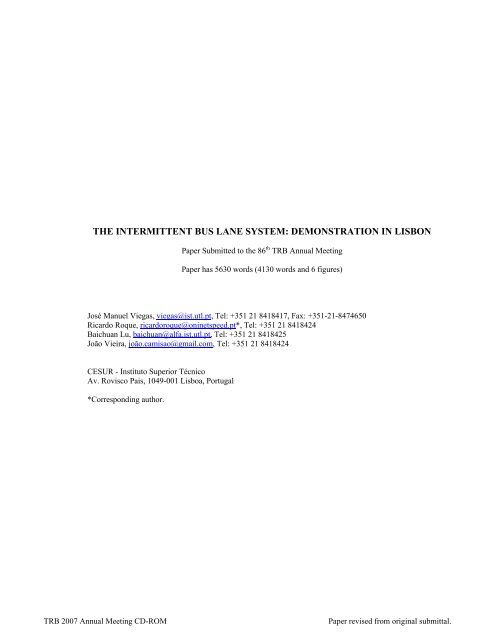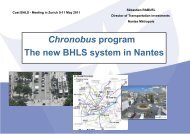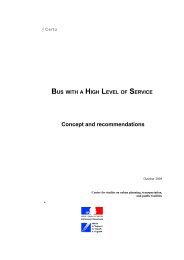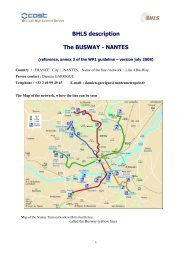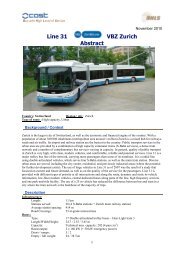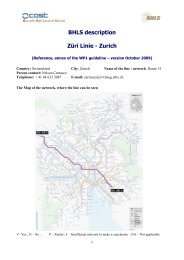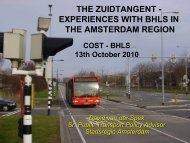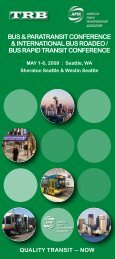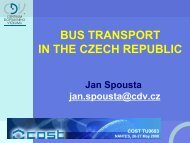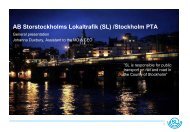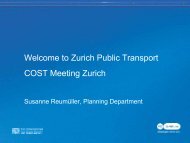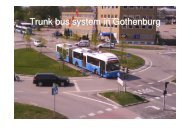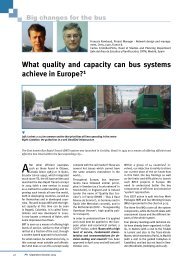the intermittent bus lane system: demonstration in lisbon
the intermittent bus lane system: demonstration in lisbon
the intermittent bus lane system: demonstration in lisbon
Create successful ePaper yourself
Turn your PDF publications into a flip-book with our unique Google optimized e-Paper software.
THE INTERMITTENT BUS LANE SYSTEM: DEMONSTRATION IN LISBON<br />
Paper Submitted to <strong>the</strong> 86 th TRB Annual Meet<strong>in</strong>g<br />
Paper has 5630 words (4130 words and 6 figures)<br />
José Manuel Viegas, viegas@ist.utl.pt, Tel: +351 21 8418417, Fax: +351-21-8474650<br />
Ricardo Roque, ricardoroque@on<strong>in</strong>etspeed.pt*, Tel: +351 21 8418424<br />
Baichuan Lu, baichuan@alfa.ist.utl.pt, Tel: +351 21 8418425<br />
João Vieira, joão.camisao@gmail.com, Tel: +351 21 8418424<br />
CESUR - Instituto Superior Técnico<br />
Av. Rovisco Pais, 1049-001 Lisboa, Portugal<br />
*Correspond<strong>in</strong>g author.<br />
TRB 2007 Annual Meet<strong>in</strong>g CD-ROM<br />
Paper revised from orig<strong>in</strong>al submittal.
ABSTRACT<br />
The concept of Intermittent Bus Lane (IBL) was <strong>in</strong>troduced by Viegas (1996) as an <strong>in</strong>novative approach to achieve<br />
<strong>bus</strong> priority. The IBL consists of a <strong>lane</strong> <strong>in</strong> which <strong>the</strong> status of each section changes accord<strong>in</strong>g to <strong>the</strong> presence or not<br />
of a <strong>bus</strong> <strong>in</strong> its spatial doma<strong>in</strong>: when a <strong>bus</strong> is approach<strong>in</strong>g such a section, <strong>the</strong> status of that <strong>lane</strong> is changed to BUS<br />
<strong>lane</strong>, and after <strong>the</strong> <strong>bus</strong> moves out of <strong>the</strong> section it becomes a normal <strong>lane</strong> aga<strong>in</strong>, open to general traffic. Therefore<br />
when <strong>bus</strong> services are not so frequent, general traffic will not suffer much, and <strong>bus</strong> priority can still be obta<strong>in</strong>ed.<br />
The <strong>the</strong>oretical development of <strong>the</strong> IBL has already been concluded, establish<strong>in</strong>g <strong>the</strong> required relationships<br />
among <strong>bus</strong> motion, general traffic flow and <strong>the</strong> related IBL signals and traffic signals at <strong>in</strong>tersections. Also a<br />
simulation of <strong>the</strong> concept has been developed, and its results suggest that average <strong>bus</strong> travell<strong>in</strong>g times can be<br />
reduced by as much as 30% with small decrease <strong>in</strong> <strong>the</strong> general traffic average speeds. Besides <strong>the</strong>se results a real<br />
world <strong>demonstration</strong> was considered necessary to act as a prototype.<br />
This paper describes <strong>the</strong> <strong>demonstration</strong> carried out <strong>in</strong> Lisbon, <strong>in</strong> cooperation between <strong>the</strong> University, <strong>the</strong><br />
Municipality and <strong>the</strong> urban <strong>bus</strong> operator (CARRIS), for a period of 6 months start<strong>in</strong>g on September 2005. The ma<strong>in</strong><br />
results obta<strong>in</strong>ed reveal an overall <strong>in</strong>crease of up to 20% <strong>in</strong> <strong>the</strong> <strong>bus</strong> average speed, with very limited impacts to <strong>the</strong><br />
general traffic movements.<br />
TRB 2007 Annual Meet<strong>in</strong>g CD-ROM<br />
Paper revised from orig<strong>in</strong>al submittal.
Viegas, José Manuel; Roque, Ricardo; Lu, Baichuan; Vieira, João; 1<br />
1. INTRODUCTION<br />
Dur<strong>in</strong>g <strong>the</strong> last decades many cities developed and implemented several techniques for grant<strong>in</strong>g priority to <strong>bus</strong>es.<br />
Priority has been given ma<strong>in</strong>ly through <strong>the</strong> def<strong>in</strong>ition of <strong>lane</strong>s or roads <strong>in</strong> which only Public Transport is allowed to<br />
flow or by giv<strong>in</strong>g priority at <strong>in</strong>tersections. The traditional <strong>bus</strong> <strong>lane</strong> has, s<strong>in</strong>ce <strong>the</strong> 1970s, become widely accepted as<br />
a means of allow<strong>in</strong>g <strong>bus</strong>es to avoid traffic queues and improve <strong>the</strong>ir speed and service, and <strong>the</strong>refore combat<br />
automobile dom<strong>in</strong>ated traffic growth and congestion. The priority given at <strong>in</strong>tersections, us<strong>in</strong>g signal controls, was<br />
made possible by several developments <strong>in</strong> computer, communications, sensors and Automatic Vehicle Locations<br />
(AVL). Despite <strong>the</strong>se developments many road l<strong>in</strong>ks throughout <strong>the</strong> cities still don’t have any effective priority<br />
<strong>system</strong> and <strong>the</strong> <strong>bus</strong> service is significantly affected by congestion.<br />
This paper presents <strong>the</strong> improvements achieved <strong>in</strong> <strong>the</strong> implementation of a <strong>demonstration</strong> <strong>in</strong> Lisbon,<br />
Portugal of an Intermittent Bus Lane (IBL), a concept <strong>in</strong>troduced by Viegas (1996) and <strong>the</strong>oretically developed by<br />
Viegas and Baichuan (2001 and 2004). In those papers, <strong>the</strong> concept, structure, operations, <strong>the</strong> movements of <strong>bus</strong>es<br />
and o<strong>the</strong>r vehicles on IBL, modell<strong>in</strong>g, and optimal control equations, all have been described <strong>in</strong> detail.<br />
Follow<strong>in</strong>g that <strong>the</strong>oretical development a <strong>demonstration</strong> project of this priority scheme was implemented <strong>in</strong><br />
Lisbon, as <strong>the</strong> result of a protocol between <strong>the</strong> University (where <strong>the</strong> concept was developed), <strong>the</strong> Municipality and<br />
<strong>the</strong> urban <strong>bus</strong> operator (CARRIS). This <strong>demonstration</strong> project was meant to act as a prototype, and <strong>in</strong>cluded <strong>the</strong><br />
preparatory activities to implementation, <strong>the</strong> preparation of <strong>the</strong> control logic, <strong>the</strong> simulation of <strong>the</strong> experience <strong>in</strong> a<br />
traffic simulation model, a real world application and <strong>the</strong> evaluation of its results.<br />
This paper syn<strong>the</strong>sises <strong>the</strong> most important aspects of <strong>the</strong> IBL Demonstration Project <strong>in</strong> Lisbon and presents<br />
its ma<strong>in</strong> results. In Section 2 <strong>the</strong> IBL concept is presented and its operational <strong>system</strong> def<strong>in</strong>ed, followed by <strong>the</strong><br />
presentation of <strong>the</strong> <strong>demonstration</strong> project <strong>in</strong> Lisbon (Section 3). Section 4 presents <strong>the</strong> methodology to evaluate <strong>the</strong><br />
impacts of <strong>the</strong> <strong>demonstration</strong> and <strong>in</strong> Section 5 <strong>the</strong> ma<strong>in</strong> results obta<strong>in</strong>ed with <strong>the</strong> <strong>in</strong>stallation of <strong>the</strong> IBL are<br />
presented; Section 6 presents <strong>the</strong> simulation of <strong>the</strong> IBL and Section 7 <strong>the</strong> conclusions of this experience.<br />
2. THE CONCEPT OF INTERMITTENT BUS LANE (IBL)<br />
The concept of IBL was <strong>in</strong>troduced <strong>in</strong> 1996 based on a few simple pr<strong>in</strong>ciples:<br />
• Bus commercial speed and reliability are improved whenever <strong>bus</strong>es are able to flow <strong>in</strong>dependently from<br />
general traffic;<br />
• To provide (permanent) Bus Lanes <strong>in</strong> road sections where <strong>bus</strong> frequency is low is ra<strong>the</strong>r <strong>in</strong>efficient, as that<br />
<strong>lane</strong> could be serv<strong>in</strong>g a bigger number of travellers if it was also available for general traffic;<br />
• But, if those road sections are congested <strong>the</strong> few <strong>bus</strong>es us<strong>in</strong>g <strong>the</strong>m will suffer significant delays due to<br />
congestion, affect<strong>in</strong>g service throughout <strong>the</strong> l<strong>in</strong>es us<strong>in</strong>g <strong>the</strong>m. This could be avoided if one <strong>lane</strong> was reserved to <strong>the</strong><br />
<strong>bus</strong> just for <strong>the</strong> time enough to allow it to move separately from general traffic.<br />
Thus, an IBL consists of a <strong>lane</strong> <strong>in</strong> which <strong>the</strong> status of each section changes accord<strong>in</strong>g to <strong>the</strong> presence or not<br />
of a <strong>bus</strong> <strong>in</strong> its spatial doma<strong>in</strong>: when a <strong>bus</strong> is approach<strong>in</strong>g such a section, <strong>the</strong> status of that <strong>lane</strong> is changed to Bus<br />
Lane, and after <strong>the</strong> <strong>bus</strong> moves out of <strong>the</strong> section it becomes a regular <strong>lane</strong> aga<strong>in</strong>, open to general traffic. Due to this<br />
“variable status” an IBL will provide a <strong>bus</strong> <strong>lane</strong> for <strong>the</strong> time strictly necessary for each <strong>bus</strong> to pass <strong>in</strong> that road<br />
section without be<strong>in</strong>g delayed by general traffic. As <strong>the</strong> restrictions to use <strong>the</strong> <strong>lane</strong> are only applied when a <strong>bus</strong> is<br />
com<strong>in</strong>g, one can expect that <strong>the</strong> efficiency of this k<strong>in</strong>d of <strong>bus</strong> priority scheme is almost <strong>in</strong>dependent from <strong>bus</strong><br />
frequency (<strong>in</strong> <strong>the</strong>ory, <strong>the</strong> lower <strong>the</strong> <strong>bus</strong> frequency is <strong>the</strong> more time <strong>the</strong> <strong>lane</strong> is available to general traffic and so less<br />
<strong>in</strong>convenience is caused). Naturally, as <strong>bus</strong> frequency <strong>in</strong>creases, <strong>the</strong> case for a permanent <strong>bus</strong> <strong>lane</strong> grows.<br />
The implementation of <strong>the</strong> IBL is made possible by developments <strong>in</strong> AVL, which are currently ma<strong>in</strong>ly used<br />
to control routes and drive passenger <strong>in</strong>formation <strong>system</strong>s (Horbury, 1999). Comb<strong>in</strong><strong>in</strong>g several current technologies<br />
fully available <strong>in</strong> <strong>the</strong> market, <strong>the</strong> concept of IBL technique can be realized <strong>in</strong> several practical ways. The prototype<br />
developed <strong>in</strong> Lisbon lies on <strong>the</strong> follow<strong>in</strong>g operational mechanism:<br />
• The IBL controller should be able to monitor traffic conditions <strong>in</strong> real time; by be<strong>in</strong>g connected to local<br />
detectors it can receive <strong>in</strong>formation about flow, speed and queues <strong>in</strong> several monitor<strong>in</strong>g po<strong>in</strong>ts along <strong>the</strong> axes where<br />
<strong>the</strong> IBL is implemented.<br />
• Also, <strong>the</strong> IBL controller has to be able to determ<strong>in</strong>e <strong>bus</strong> position with<strong>in</strong> <strong>the</strong> IBL site and <strong>in</strong> its approach<strong>in</strong>g<br />
area (to estimate <strong>the</strong> time when a <strong>bus</strong> is go<strong>in</strong>g to arrive <strong>in</strong> <strong>the</strong> IBL); this <strong>in</strong>formation can be ga<strong>the</strong>red locally by<br />
detectors activated by <strong>bus</strong>es and remotely by <strong>the</strong> reception of data directly from fleet management <strong>system</strong>s of <strong>the</strong><br />
<strong>bus</strong> operators, normally based on GPS.<br />
TRB 2007 Annual Meet<strong>in</strong>g CD-ROM<br />
Paper revised from orig<strong>in</strong>al submittal.
Viegas, José Manuel; Roque, Ricardo; Lu, Baichuan; Vieira, João; 2<br />
• When <strong>the</strong> <strong>system</strong> estimates that a <strong>bus</strong> will arrive at <strong>the</strong> IBL and face traffic conditions that can delay its<br />
movement, <strong>the</strong> IBL should be activated; <strong>the</strong> activation of <strong>the</strong> IBL is transmitted to drivers <strong>in</strong> that area us<strong>in</strong>g a<br />
comb<strong>in</strong>ation of vertical Variable Message Signs (VMS) and a set of horizontal LEDs, placed on <strong>the</strong> l<strong>in</strong>e separat<strong>in</strong>g<br />
<strong>the</strong> <strong>lane</strong>s, that will be flash<strong>in</strong>g when <strong>the</strong> IBL is “on” (<strong>the</strong> period <strong>in</strong> which <strong>the</strong> signalized <strong>lane</strong> is reserved for <strong>bus</strong>es<br />
only).<br />
• When <strong>the</strong> <strong>system</strong> determ<strong>in</strong>es that no more priority is needed (because traffic conditions are fluid enough or<br />
no <strong>bus</strong>es are <strong>in</strong>side <strong>the</strong> IBL or approach<strong>in</strong>g it) all signalization should be turned off, and <strong>the</strong> <strong>lane</strong> operates as a<br />
regular one (be<strong>in</strong>g accessible to any k<strong>in</strong>d of vehicle).<br />
It is important to mention that vehicles <strong>in</strong>side <strong>the</strong> IBL when it is activated (i.e. when <strong>the</strong> signalization is<br />
turned on) should not move sideways to o<strong>the</strong>r <strong>lane</strong>s, because that would create traffic conflicts, lead<strong>in</strong>g to flow<strong>in</strong>g<br />
capacity and safety problems: <strong>the</strong>y are supposed to drive on forward, and <strong>the</strong> <strong>system</strong> should compute <strong>the</strong> advance<br />
time needed to pre-empt <strong>the</strong> section from that traffic before <strong>the</strong> <strong>bus</strong> enters <strong>the</strong> section.<br />
3. THE DEMONSTRATION PROJECT IN LISBON<br />
The IBL <strong>demonstration</strong> project <strong>in</strong> Lisbon was developed from January 2005 to June 2006. Dur<strong>in</strong>g <strong>the</strong> first months<br />
efforts were concentrated <strong>in</strong> <strong>the</strong> preparatory activities to implementation; <strong>in</strong> September 2005 <strong>the</strong> IBL started<br />
operat<strong>in</strong>g. Between September 2005 and June 2006 <strong>the</strong> ma<strong>in</strong> activities were <strong>the</strong> monitor<strong>in</strong>g and updat<strong>in</strong>g of <strong>the</strong> IBL<br />
<strong>system</strong> and <strong>the</strong> evaluation of its results.<br />
After review<strong>in</strong>g several possible areas for <strong>the</strong> <strong>demonstration</strong> <strong>in</strong> Lisbon, check<strong>in</strong>g <strong>the</strong> geometry, <strong>the</strong> real<br />
traffic flow situations and <strong>bus</strong> movements <strong>in</strong> each area, seven favourite places for IBL application were identified.<br />
After discussion with <strong>the</strong> Municipality and CARRIS (project partners), <strong>the</strong> site at <strong>the</strong> “Alameda da Universidade”<br />
was selected as <strong>the</strong> first IBL test<strong>in</strong>g area.<br />
The area of “Alameda da Universidade” is located near <strong>the</strong> border of Lisbon’s Central Bus<strong>in</strong>ess District,<br />
be<strong>in</strong>g <strong>in</strong> <strong>the</strong> heart of Lisbon’s ma<strong>in</strong> university area. Besides be<strong>in</strong>g used as access to <strong>the</strong> universities located around<br />
it, it is also used by commuters to avoid o<strong>the</strong>r congested roads nearby, lead<strong>in</strong>g to a significant level of congestion<br />
dur<strong>in</strong>g peak hours<br />
The <strong>in</strong>stallation of <strong>the</strong> IBL was performed along 800 meters, mostly by elim<strong>in</strong>at<strong>in</strong>g illegal park<strong>in</strong>g <strong>in</strong> <strong>the</strong><br />
rightmost <strong>lane</strong>. In fact, this area was characterized by hav<strong>in</strong>g many illegally parked cars, which used to cause a<br />
reduction from two or three “potential” <strong>lane</strong>s for traffic flow<strong>in</strong>g to only one. The <strong>in</strong>stallation of <strong>the</strong> IBL was made<br />
by <strong>the</strong> re-arrangement of park<strong>in</strong>g <strong>in</strong> this area, allow<strong>in</strong>g park<strong>in</strong>g spaces <strong>in</strong> some of <strong>the</strong> former illegal park<strong>in</strong>g<br />
locations while enforc<strong>in</strong>g <strong>the</strong> prohibitions <strong>in</strong> some o<strong>the</strong>rs, lead<strong>in</strong>g to <strong>the</strong> creation of two <strong>lane</strong>s for traffic flow<strong>in</strong>g all<br />
along <strong>the</strong> implementation area, with <strong>the</strong> rightmost <strong>lane</strong> operat<strong>in</strong>g as IBL.<br />
Apart from this traffic eng<strong>in</strong>eer<strong>in</strong>g <strong>in</strong>tervention, it is important to state that <strong>the</strong> whole capacity of this road<br />
section has not been changed, as <strong>the</strong> traffic lights at <strong>the</strong> <strong>in</strong>tersection downstream, which act as major capacity<br />
restriction <strong>in</strong> this area, are still work<strong>in</strong>g as <strong>the</strong>y were prior to implementation. This is particularly important to make<br />
sure that <strong>the</strong> results obta<strong>in</strong>ed <strong>in</strong> <strong>the</strong> evaluation process can be used to assess <strong>the</strong> potential benefits obta<strong>in</strong>ed with <strong>the</strong><br />
<strong>in</strong>stallation of <strong>the</strong> IBL.<br />
The <strong>demonstration</strong> period started <strong>in</strong> September 2005 and lasted for six months. Dur<strong>in</strong>g that period several<br />
successive “technological” developments were <strong>in</strong>troduced <strong>in</strong> <strong>the</strong> IBL control logic, <strong>in</strong> <strong>the</strong> basis of a cont<strong>in</strong>uous<br />
improvement approach:<br />
• Dur<strong>in</strong>g <strong>the</strong> first 6 weeks of operation <strong>the</strong> IBL was turned on whenever a <strong>bus</strong> was detected <strong>in</strong> its<br />
entrance; <strong>in</strong> this period <strong>the</strong> <strong>system</strong> was <strong>in</strong>efficient because it operated <strong>in</strong>dependently from traffic conditions<br />
(lead<strong>in</strong>g to unnecessary activations); and was <strong>in</strong>effective as it did not apply <strong>the</strong> <strong>in</strong>formation of approach<strong>in</strong>g<br />
<strong>bus</strong>es to decide when to turn on and so <strong>in</strong> cases of severe congestion <strong>the</strong> IBL signals could not be turned on with<br />
<strong>the</strong> necessary advance to assure that <strong>the</strong> <strong>bus</strong> wouldn’t f<strong>in</strong>d vehicles queued <strong>in</strong>side <strong>the</strong> IBL.<br />
• Dur<strong>in</strong>g <strong>the</strong> follow<strong>in</strong>g 8 weeks of operation, <strong>the</strong> IBL <strong>system</strong> became more efficient as <strong>the</strong> activation<br />
started to be decided also tak<strong>in</strong>g <strong>in</strong>to account <strong>the</strong> traffic conditions <strong>in</strong> that area; as <strong>the</strong> long-range <strong>in</strong>formation<br />
about <strong>the</strong> approach<strong>in</strong>g <strong>bus</strong> was still not available <strong>the</strong> <strong>system</strong> was still <strong>in</strong>effective <strong>in</strong> periods of heavier<br />
congestion.<br />
• Dur<strong>in</strong>g <strong>the</strong> last 10 weeks of operation <strong>the</strong> <strong>in</strong>formation about <strong>the</strong> approach<strong>in</strong>g <strong>bus</strong>es was <strong>in</strong>troduced<br />
and <strong>the</strong> <strong>system</strong> performed accord<strong>in</strong>g to specification.<br />
Implementation of <strong>the</strong> concept was done at relatively low marg<strong>in</strong>al cost: on <strong>the</strong> detection side, 11 additional<br />
magnetic <strong>in</strong>duction loops were <strong>in</strong>stalled to monitor traffic conditions, as well as 3 additional detectors of <strong>bus</strong><br />
TRB 2007 Annual Meet<strong>in</strong>g CD-ROM<br />
Paper revised from orig<strong>in</strong>al submittal.
Viegas, José Manuel; Roque, Ricardo; Lu, Baichuan; Vieira, João; 3<br />
presence, all <strong>the</strong> GPS based AVL <strong>system</strong> be<strong>in</strong>g already available at <strong>the</strong> time. On <strong>the</strong> signall<strong>in</strong>g side, one VMS panel<br />
at <strong>the</strong> beg<strong>in</strong>n<strong>in</strong>g of each road block (this constitutes <strong>the</strong> legal element <strong>in</strong> accordance with <strong>the</strong> Code of <strong>the</strong> Road) plus<br />
an array of LEDs <strong>in</strong>stalled along <strong>the</strong> l<strong>in</strong>e divid<strong>in</strong>g <strong>the</strong> two <strong>lane</strong>s of <strong>the</strong> road, at 3m distance. To connect <strong>the</strong> detection<br />
and <strong>the</strong> signall<strong>in</strong>g, an additional traffic controller was <strong>in</strong>stalled <strong>in</strong> <strong>the</strong> traffic lights controller box.<br />
FIGURE 1 Vertical signalization – Variable Message Sign – located at <strong>the</strong> beg<strong>in</strong>n<strong>in</strong>g of IBL section.<br />
FIGURE 2 Horizontal signalization – LED’s on <strong>the</strong> pavement.<br />
TRB 2007 Annual Meet<strong>in</strong>g CD-ROM<br />
Paper revised from orig<strong>in</strong>al submittal.
Viegas, José Manuel; Roque, Ricardo; Lu, Baichuan; Vieira, João; 4<br />
4. METHODOLOGICAL APPROACH FOR EVALUATING THE IMPACTS OF THE IBL<br />
Before <strong>the</strong> <strong>demonstration</strong> of <strong>the</strong> IBL <strong>in</strong> Lisbon started, a detailed methodology to evaluate <strong>the</strong> impacts of that<br />
<strong>in</strong>stallation was def<strong>in</strong>ed. The ma<strong>in</strong> aspects that were monitored and evaluated were <strong>the</strong> follow<strong>in</strong>g:<br />
• Impact of <strong>the</strong> IBL on <strong>bus</strong> travell<strong>in</strong>g times;<br />
• Impact of <strong>the</strong> IBL on <strong>the</strong> general traffic flow<strong>in</strong>g conditions (flow, speed and queues);<br />
Concern<strong>in</strong>g <strong>the</strong> measurement of <strong>the</strong> impacts of <strong>the</strong> IBL on <strong>bus</strong> travell<strong>in</strong>g times a reference scenario was<br />
established, by ask<strong>in</strong>g CARRIS (<strong>bus</strong> operator) to automatically register travell<strong>in</strong>g times of <strong>the</strong> <strong>bus</strong>es <strong>in</strong> that area for<br />
one month before <strong>the</strong> <strong>in</strong>stallation of <strong>the</strong> IBL. Dur<strong>in</strong>g <strong>the</strong> 6 months of <strong>demonstration</strong> every s<strong>in</strong>gle movement of any<br />
<strong>bus</strong> with<strong>in</strong> this area was automatically registered, us<strong>in</strong>g <strong>the</strong> capabilities of <strong>the</strong> fleet management <strong>system</strong> (operated by<br />
CARRIS) which monitors <strong>bus</strong> movement <strong>in</strong> real time us<strong>in</strong>g <strong>the</strong> GPS based <strong>bus</strong> location <strong>system</strong>.<br />
In what regards <strong>the</strong> measurement of <strong>the</strong> impacts of <strong>the</strong> IBL on <strong>the</strong> general traffic flow<strong>in</strong>g conditions, <strong>the</strong><br />
ma<strong>in</strong> data providers were <strong>the</strong> loop detectors <strong>in</strong>stalled <strong>in</strong> <strong>the</strong> pavement to support IBL operations. This was not an<br />
efficient data provider to build a reference scenario (that was performed us<strong>in</strong>g manual collection of travell<strong>in</strong>g times<br />
and flows <strong>in</strong> some specific days) but it enabled <strong>the</strong> monitor<strong>in</strong>g of <strong>the</strong> various traffic attributes dur<strong>in</strong>g <strong>the</strong> experience,<br />
which can give <strong>in</strong>dications about any impacts due to IBL <strong>in</strong>stallation.<br />
In addition to all this data, it has been decided to select two weeks, dur<strong>in</strong>g <strong>the</strong> last month of <strong>demonstration</strong><br />
(March 2006) to act as “special evaluation period”. Dur<strong>in</strong>g one of <strong>the</strong>se weeks <strong>the</strong> <strong>system</strong> was turned off, while a<br />
high level of monitor<strong>in</strong>g effort was performed. The follow<strong>in</strong>g week <strong>the</strong> <strong>system</strong> was re-enacted, and <strong>the</strong> level of<br />
monitor<strong>in</strong>g effort was ma<strong>in</strong>ta<strong>in</strong>ed. The comparison of <strong>the</strong> various <strong>bus</strong> travell<strong>in</strong>g times and traffic attributes dur<strong>in</strong>g<br />
<strong>the</strong>se two weeks gives a reliable idea about <strong>the</strong> impacts of <strong>in</strong>stall<strong>in</strong>g <strong>the</strong> IBL.<br />
5. RESULTS FROM THE REAL WORLD APPLICATION<br />
In this chapter <strong>the</strong> ma<strong>in</strong> results of <strong>the</strong> evaluation are presented. It is divided <strong>in</strong> two sections: <strong>the</strong> first focuses on <strong>the</strong><br />
impacts on <strong>bus</strong> movement; while <strong>the</strong> second discusses <strong>the</strong> impacts <strong>in</strong> general traffic movement.<br />
5.1. Impacts on Bus Movement<br />
The follow<strong>in</strong>g Figure presents <strong>the</strong> comparison between <strong>the</strong> average <strong>bus</strong> speed <strong>in</strong> <strong>the</strong> first and second trimester of<br />
<strong>demonstration</strong> and <strong>the</strong> reference scenario.<br />
FIGURE 3 Average Bus Speed before <strong>the</strong> IBL <strong>in</strong>stallation and dur<strong>in</strong>g <strong>the</strong> <strong>demonstration</strong>.<br />
TRB 2007 Annual Meet<strong>in</strong>g CD-ROM<br />
Paper revised from orig<strong>in</strong>al submittal.
Viegas, José Manuel; Roque, Ricardo; Lu, Baichuan; Vieira, João; 5<br />
The results from this analysis reveal that <strong>the</strong> average <strong>bus</strong> speed <strong>in</strong>creased after <strong>the</strong> <strong>in</strong>stallation of <strong>the</strong> IBL <strong>in</strong><br />
all <strong>the</strong> l<strong>in</strong>es that use this road l<strong>in</strong>k. The results po<strong>in</strong>t to an average <strong>in</strong>crease of 2,8 km/h <strong>in</strong> <strong>bus</strong> speed, which represent<br />
an improvement of 20%. It is also important to po<strong>in</strong>t that <strong>the</strong> results <strong>in</strong> <strong>the</strong> second quarter of <strong>the</strong> <strong>demonstration</strong> are<br />
considerably better than those of <strong>the</strong> first trimester, which means that <strong>the</strong> developments <strong>in</strong> <strong>the</strong> cont<strong>in</strong>uous<br />
improvement of <strong>the</strong> <strong>system</strong> had an impact and also that <strong>the</strong> drivers’ acceptance of <strong>the</strong> <strong>system</strong> was good (particularly<br />
because police enforcement of <strong>the</strong> <strong>system</strong> was concentrated <strong>in</strong> only <strong>the</strong> first weeks of operation).<br />
The next Figure presents <strong>the</strong> variation of <strong>the</strong> average <strong>bus</strong> speed for <strong>the</strong> four <strong>bus</strong> l<strong>in</strong>es <strong>in</strong> this area throughout<br />
<strong>the</strong> day dur<strong>in</strong>g <strong>the</strong> <strong>demonstration</strong> and <strong>in</strong> <strong>the</strong> reference scenario.<br />
30,0<br />
25,0<br />
Semester with IBL<br />
Reference Scenario<br />
Average Speed (km/h)<br />
20,0<br />
15,0<br />
10,0<br />
5,0<br />
0,0<br />
6:00 7:00 8:00 9:00 10:00 11:00 12:00 13:00 14:00 15:00 16:00 17:00 18:00 19:00 20:00 21:00<br />
FIGURE 4 Variation of <strong>the</strong> Average Bus Speed along <strong>the</strong> hours of <strong>the</strong> day (<strong>in</strong> <strong>the</strong> reference scenario and<br />
after implementation of <strong>the</strong> IBL)<br />
The results show that <strong>the</strong> improvement <strong>in</strong> <strong>bus</strong> speed was achieved dur<strong>in</strong>g almost all hours of <strong>the</strong> day, but<br />
<strong>the</strong> relative <strong>in</strong>creases tend to be higher dur<strong>in</strong>g peak hours. This observation is particularly important because it has a<br />
positive consequence <strong>in</strong> <strong>the</strong> management of <strong>bus</strong> operations <strong>in</strong> this area, as <strong>the</strong> IBL seems to be contribut<strong>in</strong>g for an<br />
<strong>in</strong>creased regularity of <strong>bus</strong> circulation. A possible explanation for <strong>the</strong> lower speed of <strong>the</strong> semester with IBL <strong>in</strong> <strong>the</strong><br />
even<strong>in</strong>g period is that <strong>the</strong> reference scenario data was collected <strong>in</strong> a period with no even<strong>in</strong>g classes, which are <strong>the</strong><br />
ma<strong>in</strong> source of traffic after 19:00 hours.<br />
The comparison of <strong>the</strong> variations <strong>in</strong> <strong>bus</strong> travell<strong>in</strong>g times <strong>in</strong> <strong>the</strong> area of <strong>the</strong> <strong>demonstration</strong> dur<strong>in</strong>g <strong>the</strong> two<br />
consecutive weeks <strong>in</strong> March 2006 (one with <strong>the</strong> IBL operat<strong>in</strong>g and o<strong>the</strong>r without IBL) also revealed a significant<br />
improvement <strong>in</strong> <strong>bus</strong> movement. Results obta<strong>in</strong>ed for those weeks present a decrease <strong>in</strong> <strong>bus</strong> travell<strong>in</strong>g times <strong>in</strong> all <strong>the</strong><br />
four <strong>bus</strong> l<strong>in</strong>es, rang<strong>in</strong>g from a 5 to 14% decrease <strong>in</strong> <strong>the</strong> week <strong>the</strong> IBL was operat<strong>in</strong>g.<br />
This smaller ga<strong>in</strong> suggests that a part of <strong>the</strong> overall ga<strong>in</strong> (possibly between 5% and 10%) must be attributed<br />
to <strong>the</strong> geometric rearrangements <strong>in</strong>troduced at <strong>the</strong> outset, with an additional 10% to 15% attributed to <strong>the</strong> IBL<br />
<strong>system</strong> proper.<br />
Globally, <strong>the</strong> results of <strong>the</strong> evaluation procedure suggest a positive impact of <strong>the</strong> IBL <strong>in</strong> <strong>the</strong> <strong>bus</strong> speed <strong>in</strong><br />
<strong>the</strong> <strong>in</strong>stallation area, with an order of magnitude rang<strong>in</strong>g from 15% to 25%. It is also important to underl<strong>in</strong>e <strong>the</strong> high<br />
consistency of <strong>the</strong>se results, with <strong>the</strong> improvements be<strong>in</strong>g observed <strong>in</strong> all <strong>the</strong> <strong>bus</strong> l<strong>in</strong>es us<strong>in</strong>g this road l<strong>in</strong>k and <strong>in</strong> <strong>the</strong><br />
two methods of evaluation (cont<strong>in</strong>uous automatic monitor<strong>in</strong>g of <strong>bus</strong> movements and <strong>the</strong> comparison of <strong>the</strong> two<br />
weeks “special evaluation period”).<br />
5.2. Impacts on General Traffic<br />
As previously referred <strong>the</strong> impacts on general traffic are difficult to evaluate, as <strong>the</strong> construction of a reliable<br />
reference scenario was not possible to undertake, but a cont<strong>in</strong>uous monitor<strong>in</strong>g of traffic attributes was performed.<br />
TRB 2007 Annual Meet<strong>in</strong>g CD-ROM<br />
Paper revised from orig<strong>in</strong>al submittal.
Viegas, José Manuel; Roque, Ricardo; Lu, Baichuan; Vieira, João; 6<br />
The analysis of <strong>the</strong> traffic flows, vehicle speeds and queues accumulation dur<strong>in</strong>g <strong>the</strong> <strong>demonstration</strong> period<br />
did not reveal any significant change <strong>in</strong> <strong>the</strong> overall pattern. This leads to <strong>the</strong> conclusion that <strong>the</strong> various<br />
modifications <strong>in</strong> <strong>the</strong> IBL control <strong>system</strong> didn’t create any visible impact <strong>in</strong> <strong>the</strong> general traffic movements.<br />
In addition, <strong>the</strong> comparison of <strong>the</strong> patterns for <strong>the</strong> various <strong>in</strong>dicators of general traffic attributes <strong>in</strong> <strong>the</strong> two<br />
successive weeks <strong>in</strong> March, with and without <strong>the</strong> IBL, gave no <strong>in</strong>dication of significant changes. This leads to <strong>the</strong><br />
conclusion that <strong>the</strong> IBL <strong>in</strong> this site is not caus<strong>in</strong>g any significant impact on <strong>the</strong> ma<strong>in</strong> attributes of general traffic.<br />
5.3. Drivers Reaction to IBL<br />
Over <strong>the</strong> first weeks of <strong>the</strong> <strong>demonstration</strong> project, a public campaign to alert drivers to this new <strong>bus</strong> <strong>lane</strong> concept<br />
was carried out. At <strong>the</strong> same time, <strong>the</strong> presence of <strong>the</strong> Municipal Police, act<strong>in</strong>g on an educational level, helped<br />
drivers to understand <strong>the</strong> IBL. The <strong>in</strong>troduction of <strong>the</strong> VMS panel made a lot easier to understand when <strong>the</strong> <strong>bus</strong> <strong>lane</strong><br />
was work<strong>in</strong>g, s<strong>in</strong>ce <strong>the</strong> LED signall<strong>in</strong>g had never been used <strong>in</strong> Lisbon.<br />
In general, compliance with <strong>the</strong> <strong>system</strong> was ra<strong>the</strong>r good, as drivers understood that road space was be<strong>in</strong>g “taken<br />
away from <strong>the</strong>m” only when strictly necessary. However, <strong>in</strong> <strong>the</strong> last weeks of <strong>the</strong> <strong>demonstration</strong> a few problems<br />
occurred, possibly as some drivers came to understand that <strong>the</strong>ir misdeeds went unpunished, given <strong>the</strong> very<br />
occasional presence of police officers watch<strong>in</strong>g over this <strong>demonstration</strong> after its first weeks. This has raised our<br />
awareness that an automatic <strong>system</strong> for detection of a<strong>bus</strong>es of <strong>the</strong> Bus Lane (<strong>in</strong> active condition) would be desirable.<br />
This has been developed <strong>in</strong> <strong>the</strong> meantime and hopefully <strong>in</strong>cluded <strong>in</strong> <strong>the</strong> second <strong>demonstration</strong> site, which is to start<br />
soon.<br />
Nei<strong>the</strong>r car nor <strong>bus</strong> drivers were formally surveyed.<br />
6. MICRO-SIMULATION OF THE INTERMITTENT BUS LANE<br />
The ma<strong>in</strong> objective with <strong>the</strong> creation of a traffic micro-simulation tool for <strong>the</strong> IBL is to predict with precision <strong>the</strong><br />
effects that <strong>the</strong> <strong>in</strong>troduction of this new type of <strong>lane</strong> will have <strong>in</strong> traffic. Whereas <strong>in</strong> this first <strong>demonstration</strong>, <strong>the</strong> onsite<br />
<strong>in</strong>stallation preceded <strong>the</strong> simulation, and allowed validation of <strong>the</strong> software and calibration of many parameters,<br />
it is <strong>in</strong>tended that <strong>in</strong> a subsequent <strong>demonstration</strong> <strong>in</strong> a more complex road environment, as well as <strong>in</strong> subsequent<br />
commercial applications, simulation will precede on-site <strong>in</strong>stallation, thus m<strong>in</strong>imiz<strong>in</strong>g <strong>the</strong> risk of negative surprises<br />
and correspond<strong>in</strong>g remedial actions.<br />
As this is a totally new concept for a <strong>bus</strong> <strong>lane</strong>, <strong>the</strong> available traffic assignment software did not contemplate <strong>the</strong> use<br />
of IBL, thus mak<strong>in</strong>g necessary <strong>the</strong> development of an application to reproduce IBL <strong>in</strong> a simulation environment.<br />
AIMSUN NG was <strong>the</strong> selected software for <strong>the</strong> development of IBL’s simulation, turn<strong>in</strong>g out to be very flexible and<br />
easy to use. It was developed us<strong>in</strong>g <strong>the</strong> AIMSUN Application Programm<strong>in</strong>g Interface and is structured <strong>in</strong> a set of<br />
modules with dist<strong>in</strong>ctive functions: one for verify<strong>in</strong>g traffic conditions, ano<strong>the</strong>r for check<strong>in</strong>g <strong>bus</strong> location and a<br />
decision module for turn<strong>in</strong>g on or off <strong>the</strong> IBL. The data parameters used are <strong>the</strong> read<strong>in</strong>gs from <strong>the</strong> detectors <strong>in</strong>stalled<br />
<strong>in</strong> <strong>the</strong> model.<br />
6.1. Build<strong>in</strong>g <strong>the</strong> Micro-Simulation Model<br />
A detailed survey of <strong>the</strong> <strong>demonstration</strong> site was conducted, thus giv<strong>in</strong>g precise knowledge of <strong>the</strong> site’s geometry,<br />
signalization, park<strong>in</strong>g and traffic, lead<strong>in</strong>g to <strong>the</strong> construction of two simulation cases: one before <strong>the</strong> implementation<br />
of IBL, and ano<strong>the</strong>r one with IBL. In each one of <strong>the</strong>m <strong>the</strong> peak hours of <strong>the</strong> morn<strong>in</strong>g and afternoon were recreated,<br />
<strong>the</strong> major difference between <strong>the</strong>m be<strong>in</strong>g <strong>the</strong> existence of only one <strong>lane</strong> <strong>in</strong> <strong>the</strong> beg<strong>in</strong>n<strong>in</strong>g of Alameda for <strong>the</strong> scenario<br />
without IBL (for simulat<strong>in</strong>g <strong>the</strong> suppressed <strong>lane</strong> due to illegal park<strong>in</strong>g).<br />
TRB 2007 Annual Meet<strong>in</strong>g CD-ROM<br />
Paper revised from orig<strong>in</strong>al submittal.
Viegas, José Manuel; Roque, Ricardo; Lu, Baichuan; Vieira, João; 7<br />
FIGURE 5 An image generated by <strong>the</strong> micro-simulation model.<br />
6.2. Results and Validation of <strong>the</strong> Simulation Tool<br />
For simulation purposes, a set of four traffic scenarios based on <strong>the</strong> values of <strong>the</strong> traffic survey conducted at<br />
Alameda was created. These scenarios recreate grow<strong>in</strong>g traffic <strong>in</strong>tensities <strong>in</strong> order to evaluate <strong>the</strong> behavior of <strong>the</strong><br />
model. The results of <strong>the</strong> simulation were divided <strong>in</strong> two types: general traffic and <strong>bus</strong> l<strong>in</strong>es. The flow on an<br />
<strong>in</strong>termediate section of <strong>the</strong> model, queue lengths and travel<strong>in</strong>g times were observed for general traffic. For <strong>bus</strong> l<strong>in</strong>es,<br />
average speed and travel<strong>in</strong>g times were taken <strong>in</strong>to account. For each one of <strong>the</strong>m, results were presented confront<strong>in</strong>g<br />
both cases, with and without IBL, and Figure 6 shows one example for <strong>bus</strong> l<strong>in</strong>es mean travel time.<br />
without<br />
IBL<br />
with IBL<br />
FIGURE 6 Average Travel Times <strong>in</strong> <strong>the</strong> Afternoon for <strong>the</strong> Medium-High Traffic Intensity Scenario.<br />
TRB 2007 Annual Meet<strong>in</strong>g CD-ROM<br />
Paper revised from orig<strong>in</strong>al submittal.
Viegas, José Manuel; Roque, Ricardo; Lu, Baichuan; Vieira, João; 8<br />
Results from simulation showed that IBL can improve <strong>bus</strong> mean travel times up to 30%. For general traffic,<br />
queue formation occurred <strong>in</strong> <strong>the</strong> same time periods as <strong>in</strong> real life <strong>demonstration</strong>, and flows of <strong>the</strong> same order were<br />
obta<strong>in</strong>ed <strong>in</strong> <strong>the</strong> traffic scenario for which <strong>the</strong> <strong>in</strong>put data was closest to <strong>the</strong> traffic survey values.<br />
The results for simulation were validated through <strong>the</strong> real life <strong>demonstration</strong> results. Actually <strong>the</strong>y were<br />
very close, both show<strong>in</strong>g <strong>the</strong> ga<strong>in</strong>s that <strong>the</strong> implementation of <strong>the</strong> IBL <strong>in</strong> Alameda brought to <strong>bus</strong> l<strong>in</strong>es, and <strong>the</strong> very<br />
small impact to general traffic, thus prov<strong>in</strong>g that <strong>the</strong> simulation model is a valid tool for predict<strong>in</strong>g <strong>the</strong> behavior of<br />
<strong>the</strong> IBL <strong>in</strong> future implementations.<br />
7. CONCLUSIONS<br />
The IBL <strong>demonstration</strong> project <strong>in</strong> Lisbon succeeded <strong>in</strong> prepar<strong>in</strong>g a real world application of <strong>the</strong> <strong>system</strong>, and with it<br />
confirm<strong>in</strong>g its usability and value. Based <strong>in</strong> <strong>the</strong> <strong>the</strong>oretical developments def<strong>in</strong>ed <strong>in</strong> several earlier publications by<br />
<strong>the</strong> authors, <strong>the</strong> prototype for <strong>the</strong> <strong>system</strong> was prepared, show<strong>in</strong>g that <strong>the</strong> technological requirements for this new <strong>bus</strong><br />
priority <strong>system</strong> are fully available <strong>in</strong> <strong>the</strong> market;<br />
Dur<strong>in</strong>g <strong>the</strong> six months of <strong>demonstration</strong> several aspects were evaluated. Firstly, drivers’ reaction towards<br />
<strong>the</strong> <strong>system</strong> was good, hav<strong>in</strong>g a good level of self-compliance. Second, <strong>the</strong> quantitative evaluation of <strong>the</strong> impact of<br />
<strong>the</strong> IBL (<strong>in</strong>clud<strong>in</strong>g <strong>the</strong> geometric rearrangement done <strong>in</strong> <strong>the</strong> preparatory phase) on <strong>bus</strong> movement and general traffic<br />
flow conditions has shown promis<strong>in</strong>g results, namely:<br />
• 15 to 25% <strong>in</strong>crease <strong>in</strong> <strong>bus</strong> average speed <strong>in</strong> all routes that use this road l<strong>in</strong>k.<br />
• No significant impact <strong>in</strong> general traffic ma<strong>in</strong> attributes (flow, vehicle speed and queues) was detected.<br />
Consider<strong>in</strong>g <strong>the</strong>se results <strong>the</strong> IBL seems to present a high potential to work as a tool to improve <strong>bus</strong><br />
movement <strong>in</strong> cities. The results from <strong>the</strong> <strong>demonstration</strong> <strong>in</strong> Lisbon show that it can contribute to <strong>in</strong>crease <strong>bus</strong> speed<br />
while caus<strong>in</strong>g a limited impact to <strong>the</strong> general traffic. Tak<strong>in</strong>g <strong>in</strong>to account all <strong>the</strong> rationale, and <strong>the</strong> low marg<strong>in</strong>al cost<br />
of its implementation, it can be concluded that <strong>the</strong> IBL can be a very important mechanism to implement <strong>bus</strong><br />
priority schemes <strong>in</strong> congested road sections where <strong>bus</strong> frequency is low.<br />
8. ACKNOWLEDGMENTS<br />
The authors would like to thank CARRIS and <strong>the</strong> Lisbon Municipality for <strong>the</strong>ir <strong>in</strong>volvement <strong>in</strong> <strong>the</strong> project and for<br />
<strong>the</strong>ir f<strong>in</strong>ancial support to <strong>the</strong> research project. We would also like to thank <strong>the</strong> Portuguese M<strong>in</strong>istry of Transport for<br />
all <strong>the</strong> support <strong>in</strong> <strong>the</strong> preparation of project proposal and activities.<br />
9. REFERENCES<br />
Horbury, 1999. “Us<strong>in</strong>g non-real-time Automatic Vehicle Location data to improve <strong>bus</strong> services”.<br />
Transportation Research Part B 33 (1999) 559-579<br />
Viegas, 1996. “Turn of <strong>the</strong> century, survival of <strong>the</strong> compact city, revival of public transport.Bottlenecks”,<br />
<strong>in</strong> Transportation and <strong>the</strong> Port Industry. (H. Meersman, Ed). Antwerp, Belgium, 1996.<br />
Viegas and Lu, 2001. "Widen<strong>in</strong>g <strong>the</strong> scope for <strong>bus</strong> priority with <strong><strong>in</strong>termittent</strong> <strong>bus</strong> <strong>lane</strong>s", Transportation<br />
Plann<strong>in</strong>g and Technology Vol.24, pp87-110, 2001<br />
Viegas and Lu, 2004. "The <strong><strong>in</strong>termittent</strong> <strong>bus</strong> <strong>lane</strong> signal sett<strong>in</strong>gs with<strong>in</strong> an area", Transportation Research<br />
Part C 12 (2004) 453-469<br />
Wu and Hounsell (1998). “Bus Priority Us<strong>in</strong>g Pre-Signals”. Transportation Research Part A 32 (1998) 563-<br />
583<br />
TRB 2007 Annual Meet<strong>in</strong>g CD-ROM<br />
Paper revised from orig<strong>in</strong>al submittal.


